Abstract
The COVID-19 pandemic and the subsequent increased use of digital tools can be seen as an incentive for small and medium-sized enterprises (SMEs) to adapt to the digital age. SMEs, whose resilience and adaptability had already been tested during the previous period of the global financial crisis, were called upon to face a new emergency. The aim of this paper is twofold: (i) to investigate the evolution of digital transformation in small and medium enterprises during the pandemic of COVID-19 and (ii) to highlight the main research trends of digital transformation in the post-pandemic era. To approach these issues, a bibliometric analysis based on R package was conducted and examined 765 articles that were published in the timespan of 2014–2022. In the current bibliometric analysis, a range of indicators were applied, such as co-citation analysis of both sources and institutions, the annual scientific production, country collaboration map, world tree map and Multiple Correspondence Analysis. The bibliometric software of Biblioshiny and VOSviewer were used as the main tools to process the data and contributed to the visualization of the results. Findings of the research show that emerging technologies such as blockchain, artificial intelligence, machine learning and 3D printing have started integrating SMEs in their business models. In addition, the technology–organization–environment framework (TOE) has emerged as a niche theme in the research field of digital transformation of SMEs. The above reveals the willingness and the effort of SMEs to adapt to the new circumstances created by the pandemic of COVID-19, by transforming their business models from conventional to digital one. The social media model is also highlighted, as a new product development of SMEs during the crisis of pandemic of COVID-19. The intention to adopt both TOE business model and social media are significantly influenced by emerging technologies and can raise the awareness of government to support SMEs in this effort.
1. Introduction
In the era of the 4th Industrial Revolution, digital technologies are an integral part of our daily lives [1]. Every year new technological achievements make their appearance, bringing about drastic changes in every aspect of human life and activity. The world is transforming at a rapid pace, and we are called to respond to the new circumstances, via flexibility, speed and adaptability. As a first step, the concept of digital transformation should be understood by everyone without exception [2]. It is essential not to be confused with acquiring or using a new software or a new generation of computers, not even with the digitization of services. Digital transformation is a concept with a much broader meaning [3]. It refers to the holistic transformation of the operating model that a business follows. To achieve that, businesses are required to integrate into their business models a strong will, a clear strategy, a correct planning of needs and priorities, careful implementation and sufficient availability of resources and tools. Above all, readiness and support from the wider business community are required [4,5].
The advent of the “digital age” has coincided in recent years with a particularly turbulent period for the global economy, which was characterized by a long financial crisis. The almost ten-year crisis that hit the global economy hard, especially the weakest social strata and small businesses. A short “break of rising expectations” was followed, starting at the beginning of 2020, by a new crisis, that was primarily health but resulted in extensive negative consequences to the business life of the global community [6]. The economic recession that has occurred because of the effects of the COVID-19 pandemic is present at many levels and aspects of social and economic life, without yet knowing its duration, extent and depth. As a result, in a historical period where economic and technological developments are rapid on a global level, the wider set of small businesses is conducting a struggle for survival and continued uncertainty in a highly competitive internationalized environment. It is obvious that the topic of “digital transformation” is of particular interest to small businesses today [4]. Moreover, it is a fact that new technological developments offer new technical possibilities and business opportunities. Technological changes are in store for changes that modify the way small businesses operate, while being framed by rapidly changing economic trends and a business and financial environment that does not always appear favorable [7]. It is widely accepted that small and medium-sized enterprises (SMEs)—and especially very small ones—encounter and are expected to face extremely strong barriers to the adoption process of advanced digital technologies even at a basic level of applications. Internationally, the rate of diffusion and adoption of digital technologies slows in direct proportion to business size, with adoption rates typically lower at the micro-enterprise level [4,8].
Therefore, the questions that arise regarding the effects that new technological developments are expected to bring to the immediate horizon of small businesses are reasonable and varied. In this context, this research attempts to highlight the most basic aspects and extensions of the digital transformation of the global economy, with a particular emphasis and focus on micro and small businesses [5]. In addition, the components of this research focus both on the broader dimensions of research trends in digital transformation, such as the integration of the new “digital world” and the powerful challenges emerging for small businesses. To approach the research, questions on the scientific method of Bibliometrix were applied. The scope of the bibliometric analysis based on R package illustrates the state of the art of the field of digitalization and SEMs during the pandemic of COVID-19 and presents the research trends, as well as other related indicators by analyzing manuscripts published in Scopus [9,10]. Moreover, the software of Biblioshiny and VOSviewer contribute to the identification of the research gaps and opportunities for SMEs through the integration of digital transformation into their business models.
This manuscript is organized as follows. Section 2 discusses the importance of digital transformation of SMEs in a crisis period, focusing on the pandemic of COVID-19. Section 3 presents and discusses the materials and methods used in highlighting the research trends of digital transformation in SMEs. Section 4 discusses the key findings of our study. Section 5 summarizes the findings, outlines the research gaps, and suggests potential subjects for future surveys. Section 6 concludes the paper.
2. Literature Review
Digital Transformation Changes SMEs’ Business Models: Where the Past Meets the Future
Digital transformation has revolutionized the way companies conduct business, create relationships with consumers and suppliers as well as other stakeholders and promote business model innovation and customer value creation [4,7,8]. Therefore, digital transformation is the way in which “a company uses digital technologies to develop a new digital business model that helps the company develop its value”. This transformation affects a company’s business processes, operational routines and organizational capabilities. In addition, digital transformation, otherwise referred to as “digitization” in the international literature, refers to the integration of new technologies that contribute to the creation of new software and systems that result in the improvement in the level of competitiveness and efficiency of businesses [8,11].
The pandemic of COVID-19 has created a greater need for digital transformation, even for businesses and organizations that have traditionally underestimated the importance of investing in emerging technologies. The need for social distancing and remote working has prompted the entire business world to invest in various digital platforms and technology tools that have allowed businesses to run smoothly even in the era of COVID-19 [12]. The pandemic has caused dramatic changes in the wider business macro-environment, encouraging companies to adopt digital technology on a larger scale and under time pressure. According to studies, digital technology allows companies to transform their business models quickly, rather than in traditional or linear ways [12,13].
In particular, the digitalization of the business world has helped more small and medium-sized enterprises, which were hit hardest from the effects of COVID-19, to create a new digital network, which allows overcoming the dominance of large enterprises. Since small and medium enterprises play an important role in defining the economy of a country, the emergence and development of the digital market is very important [8,14]. The technologies of the 4th Industrial Revolution can be used to improve business resilience and continuity. Technologies such as digital supply chain, data analytics, artificial intelligence, machine learning, robotics, digital commerce and the Internet of Things can increase the resilience and agility of organizations and enable them to perform better than counterparts in turbulent or unstable environments. Moreover, the transition of SMEs to the new digital age contributes to the creation of a new digital network, which is a decisive factor for SMEs to respond to the increased competition, to promote their products in larger markets and to implement their innovative proposals with greater success [13].
In general, the degree of digital transformation is differentiated among SMEs and this has contributed to the development of the following three categories: (a) SMEs with a high standard of digital maturity, which help to the mitigation of the challenges by accelerating the transition to digitized enterprises, (b) SMEs that face challenges of liquidity and, (c) SMEs that present very limited digital literacy but are supported by a high level of social capital. Other study findings suggest that SMEs’ innovation practices have a significant impact on their performance and survival. Empirical findings reveal that innovation capability is essential for an SME’s survival during a crisis and confirm the existence of a positive impact of marketing innovation and process innovation on the financial performance of SMEs during the COVID-19 pandemic [8,11,15].
Although the category that SMEs belong to, the implementation and adoption of digital technologies as well as the utilization of digital skills, are no longer an optional activity for businesses but a key factor for survival and building new business models [16]. A few researchers in the field of digital transformation and business modeling have proposed new business models for SMEs that integrate the dimension of digital transformation and help them to adopt into the new circumstances that the pandemic of COVID-19 has caused [17]. Their business model is based on the theory of business model innovation, but they updated it with the integration of digital transformation and the triple win formula of strategic ambidexterity, agility and open innovation (Figure 1). In addition, this model help SMEs to secure their business continuity in a volatile and ever-changing environment. Additionally, it enables SMEs to generate value in this new business environment.
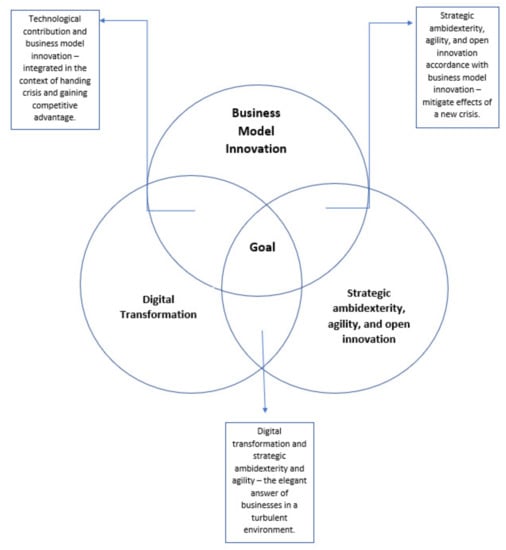
Figure 1.
A new business model innovation for SMEs based on digital transformation. Source: [17].
Moreover, another business model that as emerged as a crucial one for SMEs in mitigating the effects of the pandemic of COVID-19 is that of the technology–organization–environment framework. Based on the insight that SMEs face problems in adopting new technologies, this business framework, which was created by Tornatsky and Fleischer in 1990, can help in the description of the organizational characteristics that affect SMEs’ decisions to adopt technological innovations [18,19]. The three levels of the model are technological, organizational and environmental and influence the process by which an organization adopts and accepts a new technology presenting both its limitations and opportunities. The technology layer describes both internal and external technologies relevant to the business that may be useful in improving organizational productivity. This includes the existing technologies within the enterprise as well as the pool of technologies available in the market [20]. The organizational level is defined in terms of the available resources that support the acceptance of the innovation. Some of these criteria can be the following: the size of the firm, the concentration, standardization and complexity of its management structure, the quality of human resources and the number of idle resources available [21]. The environmental layer represents the setting in which a company conducts its business-industry, is influenced by its competitors, access to resources provided by others and dealings with government. The business model of technology, organization and environment is described in the following sections of this research work thoroughly, as it has emerged as one of the niche themes in the studied field [18,22].
3. Materials and Methods
Bibliometric analysis methods were used to provide an overview of published scientific articles. This type of analysis is based on processing the aggregated literature data provided by databases such as Scopus, Web of science (WoS) and Google Scholar. In recent years, quantitative, bibliometric methods for the evaluation of the research work have become increasingly more widespread [23,24]. A critical feature of such an evaluation process, in addition to its validity and reliability, is its efficiency.
In the current manuscript, the analyzed data were retrieved from Scopus in June 2022. Scopus is an international bibliographic database, which was started in 2004, and includes abstracts and citations for academic articles from reputable scientific journals. The database covers nearly 36,377 titles from 11,678 publishers, of which 34,346 are peer-reviewed journals in Science, Technology, Medicine and Social Sciences, including Arts and Humanities. It is owned by Elsevier and is available by subscription only. Scopus database searches incorporate searches of scientific websites through Scopus, a product of Elsevier, as well as patent databases. As Elsevier owns Scopus and is still one of the main international publishers of scientific journals, an independent and international content selection and advisory committee was established to prevent a potential conflict of interest in the selection of journals included in the database and to maintain an open and transparent content coverage policy, independent of the publisher. Scopus also offers author profiles covering collaborations, publication numbers and their bibliography data, as well as citations and details on the number of citations each published item has received. It has alerting features that allow registered users to track changes to a profile and the infrastructure to calculate the h-index of authors [9,25,26,27].
Our search in the Scopus database for the terms “digital transformation”, “COVID-19” and “SMEs” returned a sum of 2095 results. However, the usage of selected criteria resulted in 725 papers. So, the final formula that arose was the following: ((“digital transformation” OR “digitization” OR “emerging technologies”) AND (“small enterprises” OR “medium enterprises” OR “small and micro businesses” OR “medium sized businesses”) AND (“COVID-19” OR “pandemic”)). Regarding the use of Boolean operators, these are words that can be used by researchers to limit or explore the results of a search. In addition, to increase the clarity and quality of the findings, we considered only original papers for analysis, whereas other forms of publications such as book chapters, conference proceedings, and white papers were excluded. In addition, the search was based on the English language, as it is among the fastest growing languages in the modern word. The selected papers that were retrieved and analyzed were restricted within the time period 2014–2022. For the analysis and visualization of the data, Biblioshiny and VOSviewer tools were used by the authors.
Figure 2 illustrates the workflow of the methodology of this research.
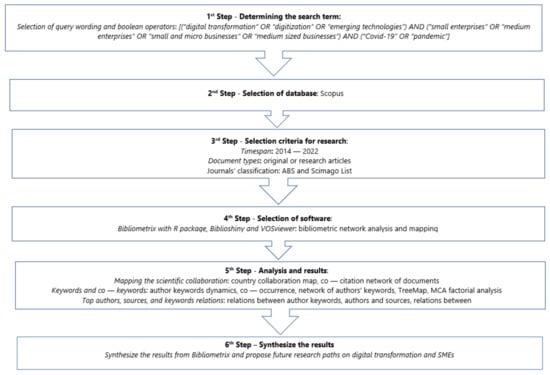
Figure 2.
Methodological flow. Source: Authors’ own elaboration.
4. Results
4.1. Evolution of the Number of Articles
In the current study, a total of 765 published original articles for the time-period 2014–2022 were analyzed. Figure 3 illustrates the annual scientific production for the research field of digital transformation of SMEs in the period of COVID-19. The sharp-edged growth in 2021 can be characterized as the peak year of publications in the research field.
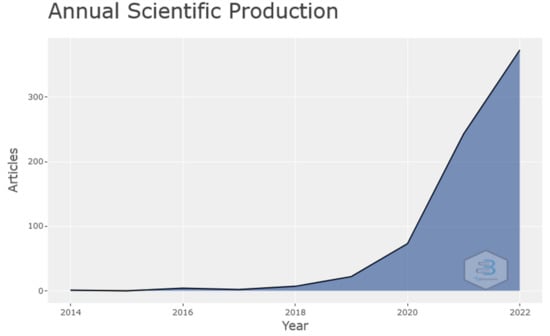
Figure 3.
Annual scientific production of publications in ambidexterity and agility in SMEs. Source: Scopus/Biblioshiny.
This increase is due to the situation that has been created by the pandemic of COVID-19, which has caused significant effects on the daily operation of the market all over the world [15]. The health guidelines/recommendations adopted globally, with the aim of minimizing travel and staying at home, as well as the imposition of restrictive measures by governments, have led businesses to reshape their daily lives. Specifically, during the pandemic, businesses were asked to cancel, definitively or even indefinitely, their face-to-face meetings and visits by interested parties to the premises of the same enterprise or to the premises/offices of third parties (customers, suppliers, partners, etc.) [28,29]. In addition, business processes were affected, postponed and/or modified especially where the infrastructures that would allow an alternative way of conducting them without requiring physical presence were absent. For some industries, of course, physical presence remains and will continue to be necessary, for example in the health, construction, logistics and security services industry. For the rest of the industries, digital technology today provides the appropriate solutions for continuous and better-quality connectivity, interactive communication, automation of processes and thus limiting the risk of disrupting the normality of business operations [30]. Today, due to the COVID-19 pandemic, the critical role of digital transformation in improving business continuity is highlighted and it is confirmed that, especially in similar crises such as the one we are experiencing nowadays and in what follows [20,31].
The journals with the highest number of more related research manuscripts in the studied research field within the time period 2014–2022 are presented in Table 1. The most related sources were integrated into this table, with the higher number of publications following with the research formula, as this is referred to in Section 3. The Journal of Business Research is highlighted as the journal with the highest number of most relevant published articles on the research field (36 articles) during the examined period. Technological Forecasting and Social Change is ranked in the second position with 13 published articles in the field of digital transformation of SMEs in the pandemic of COVID-19. Moreover, Benchmarking and International Journal of Entrepreneurial Behaviour and Research has published 14 articles each, while the top five of the most related sources is completed with the British Food Journal, which has published 13 papers in the studied field of digital transformation within SMEs. Table 1 also illustrates that the selected journals enclose a range of different research areas with implications for businesses and management, such as strategy and management, business, management and accounting and decision sciences. In addition, the selected journals are indexed by both the lists of Scopus and Scimago, as well as ABS list too. Regards the h-index, the average is close to 87, which reveals that the published research articles in the studied field receive more than 87 citations each. This is a satisfactory metric which highlights the importance, significance, and broad impact of research on digitalization of SMEs in the period of COVID-19.

Table 1.
Most relevant publications in the field of digital transformation of SMEs during the pandemic of COVID-19.
Moreover, co-citation analysis of the relevant sources in the research field (Figure 3) provides a more forward-looking assessment of the sources. Figure 4 organizes the sources in five clusters, while findings of the figure confirm that of Table 1. Thus, the Journal of Business Research is highlighted as the journal with the most related research works in the field of digital transformation of SMEs during the pandemic of COVID-19.

Figure 4.
Map of co-citation analysis of the most relevant publications in the research field. Source: Scopus/VOSviewer.
4.2. Geographical Collaboration Analysis
Table 2 illustrates the countries with the highest production of scientific papers in the field of digital transformation of SMEs in the pandemic of COVID-19 for the timespan 2014–2022, while the same data were visualized with the use of GIS software (Figure 5).

Table 2.
Scientific production of the main countries related to the digital transformation of SMEs.
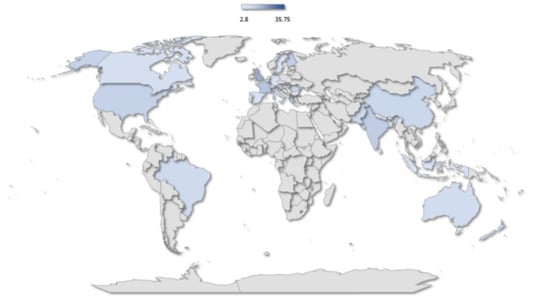
Figure 5.
Scientific production of the main countries related to the digital transformation of SMEs. Source: Scopus/Biblioshiny.
The total number of citations represents the average article citations per annum. Among the countries, the United Kingdom has been observed as the country with the highest scientific production in the research field of digital transformation of SMEs. UK SMEs present a high rate of adoption of emerging technologies compared to the rest of their European peers. Studies have shown that 51% of British SMEs set the question of their digitization as their top priority for the coming years [8,16]. Although, the pandemic of COVID-19 has prompted businesses to accelerate their digitization plans, which has come with a set of challenges, such as telecommuting, downsizing because of the minimization of their revenues and the development of their physical stores to digital one in a night to continue selling. However, the most cited research works are not British, but from Hong Kong, where scientific papers in the field of digital transformation of SMEs have been cited 35.75 times. Hong Kong is always at the cutting edge of technology, economic activity and innovation [32,33]. Thus, it is not surprising that Hong Kong has become one of the paragon countries globally regarding its immediate response to the spread of the coronavirus and taking drastic measures for the health and safety of citizens, using domestic technological weapons. Starting from the International Airport of Hong Kong, where humans and robots worked together to stop the deadly virus, to small and medium enterprises, which are a key economic pillar of the country’s economy, are just a few examples of how companies operating in Hong Kong immediately incorporated emerging technologies to mitigate the effects of pandemic of COVID-19 [34,35]. The digital world presents a high set of business opportunities for SMEs in Hong Kong and has the potential for a wider transformation across the economy. In Hong Kong, SMEs that have integrated the emerging technologies into their business model have managed to strengthen their competitiveness. But in the country there are three types of SME gears regards the digital transformation: (i) those that have not moved to the digital world, so they should focus more on the importance of usage and value of the digital transformation, (ii) those SMEs that present low and medium digital engagement, thus they should make efforts to increase their level of digital engagement and (iii) SMEs with high digital engagement, which need to develop their strategy even more, in terms of their digital transformation [36,37].
In addition, Figure 6 highlights the geographical collaboration between the scholars in the research field of digital transformation of SMEs in the turbulent period of the pandemic of COVID-19. The mapping of the scientific collaboration of the scholars in the global community was created with the use of the Biblioshiny tool [17]. The goal of this geographical collaboration analysis is to present the social structure of the research community in the studied field. Each of the nodes in the graph shows the authors and the link-lines represent the co-authorship. The map presents the United States as the origin of most of the scientific collaborations in the field of digital transformation of SMEs, as well as the strongest scientific channels recorded among USA-Europe and USA-China.
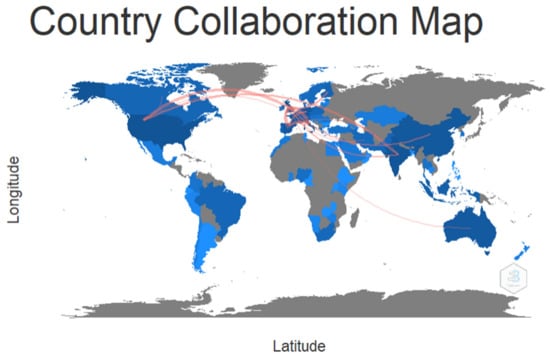
Figure 6.
Country collaborations map. Source: Scopus-Biblioshiny.
Moreover, the map of the co-citation analysis of institutions reveals the dynamics of these institutions in the research field (Figure 7). In the figure, there are eight clusters and 30 items.
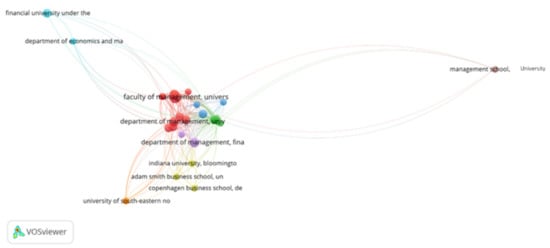
Figure 7.
Map of co-citation analysis of institutions. Source: Scopus/VOSviewer.
4.3. Key Word Analysis
The authors’ keyword analysis is a bibliometric tool that helps both researchers and search engines to identify the most relevant papers of the research field that they are interested in [38,39]. In addition, the authors’ keyword analysis can contribute to the increase of the number of readers of the paper, which means that the manuscript can be more cited by scholars. In addition, analysis of authors’ keywords can lead to the identification of the research trends, as well as the gaps in the studied field. Figure 8 and Figure 9 presents the Word TreeMap, which indicate the top 50 most used keywords in the manuscripts on the research field of digital transformation of SMEs for the timespan 2014–2018 and 2019–2022 respectively. The TreeMap in Figure 8 indicates the concepts of digitalization, financial services and innovation, as the top three of the most cited keywords, in the research field of businesses’ digital transformation for the time period 2014–2018. Results during this period show that businesses started integrating digitalization and innovative services in their business model. Among the sectors that followed this path, finance was the first that directly integrated into the new digital world. Particularly, the sector introduced financial services exclusively through emerging technologies. This form of services is well known as Fintech and came to revolutionize the finance sector [40,41].
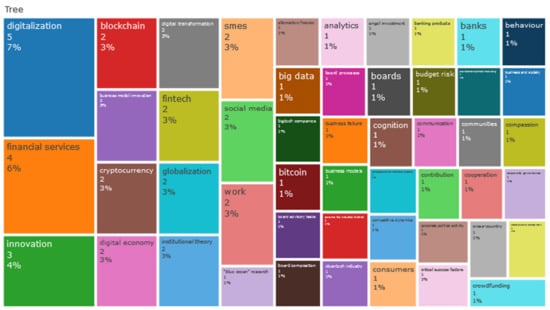
Figure 8.
Word Tree map for the timespan 2014–2018. Source: Scopus-Biblioshiny.
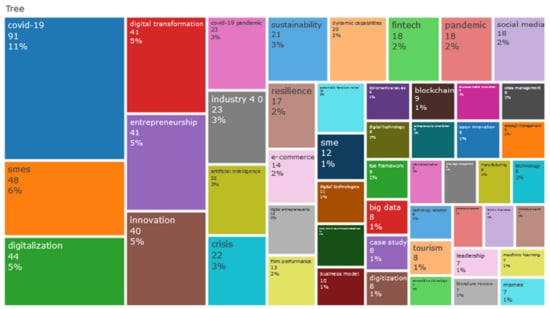
Figure 9.
Word Tree map for the timespan 2014–2018. Source: Scopus-Biblioshiny.
TreeMap in Figure 9 highlighted the situation created by the pandemic of COVID-19, which had significant effects on the daily operation of SMEs, resulting in their decision to integrate new technologies and follow the path of digital transformation. Thus, the very concept of digital transformation has “ripened” in SMEs consciousness and findings come to a critical conclusion: without the digital technologies that have enabled the possibility of telecommuting and remote transactions during the COVID-19 pandemic, the effects on the competitiveness, employment and business continuity of SMEs would be multiple [7,22,42,43]. So, the pandemic of COVID-19 set a modern digital culture, which places digital transformation in the core of SMEs, as a strategic choice and not as a “flag of opportunity” [44].
Furthermore, the crucial role of COVID-19 and its impact in the transformation of SMEs to the digital environment is also highlighted by Figure 10. This figure presents the network visualization based on the co-occurrence of the authors’ keywords [45,46]. To visualize these data, the bibliometric software of VOSviewer was applied. VOSviewer is software that helps researchers to build a bibliometric network, as well as to visualize the information of this network. Each of the circle presents the occurrence and the bigger the size of the circle, the stronger is the co-occurrence of authors’ keywords. The similar color of the circles indicates the cluster of the keywords, and the lines between the circles illustrates the link between the keywords. A total of 55 words were selected and divided into seven clusters, and each cluster has a different color. Cluster in red and purple color represent the digitalization and digital transformation of SMEs respectively, while cluster in orange highlights SMEs and yellow color represents the crucial role of COVID-19 in the transformation of SMEs during this period. In addition, cluster in light blue color highlights the transformation of entrepreneurship from the conventional to the digital form. Lastly, clusters in dark blue and green color represents the factor of innovation and the need for a new business model. So, the above analysis has emphasized the decisive role of COVID-19 on the digital transformation of SMEs and the need for a new business model that will help SMEs to adapt faster in the new circumstances.
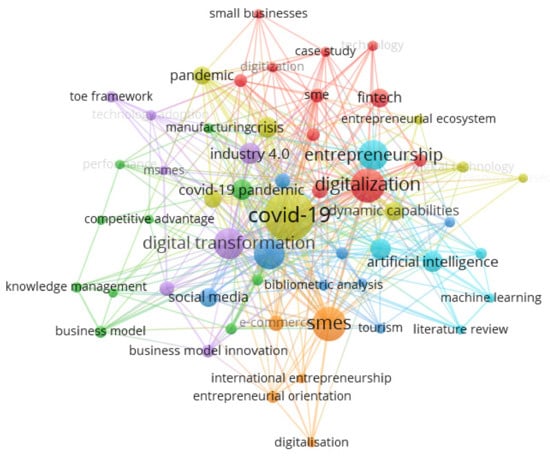
Figure 10.
Network visualization–co-occurrence of author keywords. Source: Scopus–VOSviewer.
However, the need of SMEs for a business model that will help them to adjust quicker and safer in the digital community can be identified by a thematic map (Figure 11). Figure 11 presents the research themes which are obtained from the Bibliometric analysis. Each of the clusters in the graph indicate the themes of the research, while the size of the clusters highlights their proportionality to the number of the keywords. Each of the quadrants represents a different research theme [47]. The quadrant in the up-right position of the figure illustrates the motor themes, which are characterized by high centrality and density. Niche themes are represented by the quadrant in the up-left position of the thematic map and is characterized by low centrality and high density. Moreover, themes that are placed in the low-right position of the thematic map are known as basic themes, while low-left quadrants represent the emerging themes which are defined by low centrality and density. So, the business model of technology–organization–environment, which is known as TOE, is presented in the emerging themes of the thematic map [18,19,22]. The appearance of this model indicates the need of small and medium enterprises for a business model that will help them to adopt and accept the emerging technologies, such as blockchain, artificial intelligence and machine learning, deep learning. The business model of TOE contributes to the presentation of both the limitations and the opportunities that can arise from the integration of the emerging technologies. Thus, TOE business model can help SMEs to embrace technological innovations without hesitation [20].
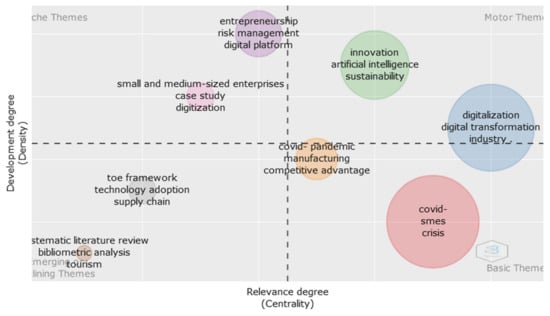
Figure 11.
Thematic map. Source: Scopus–VOSviewer.
As it has been pointed out, the analysis of the keywords used by authors in the research field of digital transformation of SMEs during the pandemic of COVID-19 contributed to extract important findings regarding the studied research area. Authors’ keyword analysis highlighted the importance of digital transformation in SMEs, as well as the need for a business model that will help them to adjust in the new digital business community. However, future research directions in the studied area can assist SMEs to revamp their strategy regarding the digital transformation of the SMEs. Multiple Correspondence Analysis (MCA) is a method that clustered the documents that were retrieved from Scopus database and indicated the road for future research. Figure 12 illustrates the findings of the MCA method. There are two clusters: the one in the red color highlights the current situation in the field of digital transformation and the cluster in blue color indicates the future research directions. So, the cluster in blue color highlights the need for the inclusion of social media in the strategy of SMEs for adjusting in the digital community [2]. Social media platforms have created a new boom in economic growth. They offer networking to new markets and unlimited free exposure to anyone who knows their secrets and can tap into their potential. Social networking not only helps promote business, but also provides the privilege of learning from others [48]. In addition, the use of social media is a consequence of the greater use of emerging technologies, which lead to the flourish of e-commerce and digital entrepreneurship too.
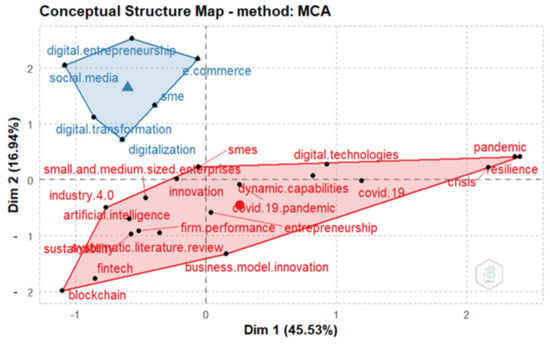
Figure 12.
Multiple Correspondence Analysis (MCA). Source: Scopus–VOSviewer.
5. Discussion
The new fluid and “unreadable” economic environment in the post-pandemic period presents multiple challenges for small businesses, among which are: (i) the need to adapt to the digital challenges arising from the escalation of the new digital revolution, (ii) dealing with an accelerating digitized economic environment as a consequence and the effects of COVID-19, which is expected to sharpen and worsen trends of digital backwardness and “digital divides” between digitally advanced and less digitally developed enterprises and (iii) the survival and development of micro and small enterprises in a broader environment of economic slowdown and recession, macroeconomic and financial constraints but also intensified competition and potentially enhanced concentration in specific industries. The combination of all the above developments creates reasonable questions and makes the present research particularly timely, given that on the one hand it offers a snapshot of the previous state of small businesses in a few relevant parameters [44,49]. On the other hand, it enables the investigation of specialized fields that were directly affected or accelerated by COVID-19 (e.g., electronic transactions and orders, use of new digital technologies, electronic transactions of businesses with the state), in relation to new forms of differentiation and “ dualisms’ (e.g., digitally mature or less prepared businesses).
Examining the above dimensions provides a comprehensive picture of digital readiness as well as the level of digital adaptation, while also outlining the expected trajectory and key digital maturation trends for a large segment of small businesses in the coming years [7,15]. However, the relatively low degree of familiarity and integration of new digital systems, the low degree of need for further digitalization, the low degree of exploitation of the possibilities of e-commerce and e-procurement, the limited degree of need for digital skills, as well as the low degree of digital adaptation investments that rely excessively on equity capital to a limited extent other than available financing possibilities, constitute some precursor indicators that highlight the risk of worsening digital contrasts and differences at the level of small enterprises, mainly between digitally mature and less digitally adapted enterprises. Accordingly, beyond the horizontal assessment of the digital maturity of small businesses, it is evident that the level of digital maturity is not distinguished by homogeneity across the wider range of domestic businesses. SMEs are distinguished by internal differentiation in their digital maturity based on parameters such as industry/sub-industry (e.g., high/low knowledge intensity), size, core activity and business model as well as geographic location. Therefore, the observed trends reflect the emergence of a new development dualism and “techno-production gap” at the level of small firms among “islands of firms” that adapt more quickly to technological developments through investment, skill upgrading and integration of new technological factors and to the wider segment of small businesses that are growing exceptionally well with limited digital adaptation activity through limited-scale investments and actions [50,51,52,53].
Consequently, the implementation of targeted and specialized digital development measures for small businesses is an imperative condition of digital upgrading and a fundamental component of modern policies promoting digital transformation, both at the level of direct interventions in terms of development of key digital capabilities as well as the long-term survival and growth prospects of micro-enterprises in the new digital age. Moreover, the development of a business model will be vital to the encouragement of SMEs to embrace more services of digital transformation. The business model of technology–organization–environment (TOE) has emerged from bibliometric analysis as one of the most ideal for SMEs. TOE gives the opportunity to SMEs to understand the pros and cons of the digitalization of their business and the way that the emerging technologies can leverage their business and increase their competitiveness, productivity and effectiveness. Additionally, findings show that SMEs should invest more on social media [19,54]. Specifically, the concept of social media marketing is one of the most modern approaches to the digital community of marketing. Social media marketing concerns the use of social media by companies as channels of communication and promotion of a company’s brand and its products/services. Essentially, this type of marketing can be considered as a subset of digital marketing, complementing various Internet-based promotion strategies, such as online advertising campaigns and e-mail newsletters, with the goal of reaching target consumers more effectively [55,56]. So, the above can act as a springboard to government to support SMEs in integrating emerging technologies and creating new open services. For example, findings of this research can lead government to develop policies and procedures with the main purpose of them to be the enhancement of the digital maturity of a country’s small and medium-sized enterprises that are active in a wide range of sectors of the economy. Through this program, participating companies can be strengthened to modernize their production, commercial and administrative operations, upgrade the way of communication and collaboration and introduce new forms of hybrid work (hybrid workplace), digitize electronic transactions with customers and partners, including and e-commerce and increase the level of security and trust in electronic transactions, through the exploitation of new digital products and services.
The importance of a new business model for SMEs based on the principles of the TOE framework has been highlighted, which helps SMEs to overcome their fear regarding their transformation from a conventional to a digital environment in the context of COVID-19. However, the fear of the integration of emerging technologies was not the only inhibitor factor regarding the decision of SMEs towards digitalization. Generally, the relationship between digitalization and SMEs can be characterized as somewhat complicated, while there are factors that impact this relationship both positively and negatively (Figure 13). There are a range of factors that can positively or negatively affect the decision of SMEs to adapt in the digital era such as: (i) fiscal policies in response to the COVID–19 pandemic, (ii) monetary policies in response to the COVID-19 pandemic, (iii) non-pharmaceutical interventions, (iv) effects of the pandemic on labor markets and (v) overall pre-pandemic trends. Considering the first factor referred above, small and medium-sized businesses have been particularly vulnerable to the economic impact of the COVID-19 pandemic. Although, the goal of governments to relieve small and medium-sized enterprises from the economic challenges they were called to face during the pandemic became particularly important. Thus, governments implemented interventions, which included a range of fiscal and monetary policies, as well as initiatives aimed at promoting digital transformation. In addition to fiscal interventions, policymakers should concentrate on the effects of the pandemic in the labor markets. For example, Singapore’s government has encouraged, through a special fiscal support package, SMEs in the food and beverage sector to switch from offline to online sales. In particular, the government provided businesses with the necessary financing in food stores to conduct remote transactions and deliver products through five specially configured product delivery platforms. So, research for future proposals should focus on the investigation of the five above factors in the decision of SMEs for digitalization.
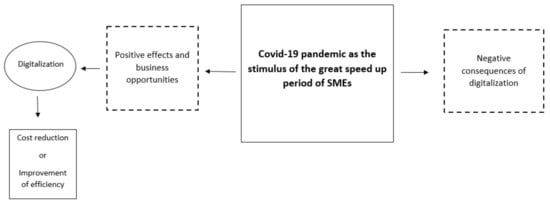
Figure 13.
A framework of the relationship between SMEs and digitalization.
During the pandemic, governments have implemented many important steps to advance the digital agenda of businesses, but more actions are needed to develop digital services and stimulate the digitization of businesses. This includes promoting competition and incentivizing interoperability in digital markets, increasing the availability of digital and complementary skills and enhancing access to innovation finance. However, ensuring transparency remains a key issue. The key features of transparency, trust and variability can improve the functionality of businesses, increasing the efficiency, security and verifiability of how they operate with a positive social impact. Therefore, the investigation of tools and policies that can assure transparency for SMEs in a digital environment can be an ideal proposal for future research. Moreover, another proposal for future research can focus on the investigation of the digitalization of the logistic department of SMEs. Digital transformation in logistics represents the path from which it depends on the competitiveness and sustainability of entrepreneurship. The COVID-19 pandemic has highlighted the need for greater flexibility, faster response and resilience of businesses in the sector to fluctuations in demand and supply. In this context, the utilization of solutions incorporating industry/logistics 4.0 technologies have been proven in practice to be the best solution for their response to the challenges of the emerging new era [57,58].
6. Conclusions
The debate on the role of technology in economic growth and socioeconomic development has always been a central subject of social, economic and political analysis [8]. However, in specific historical periods, technological progress seems to be an even more central field of scientific dialogue, on the one hand as a consequence of the accumulation of important technological developments that changes the whole of the so-called “techno-economic paradigms” affecting the whole of economic and productive activity on multiple levels, and on the one hand, as a result of dominant economic and political options for productive restructuring and socioeconomic transformation [28].
The discussion of the current technological revolution and in particular the dimension of digitization and digital transformation (often also identified with the concept of the “4th Industrial Revolution”) boils down to the combined exponential growth of critical technologies in a wide range of complementary subject areas (e.g., artificial intelligence and machine learning, nanotechnology, photonics and micro/nano-electronics, sensors and the Internet of Things, advanced materials, biotechnology, IT, technologies, robotic systems), as well as in their generalized application and interconnection with all industrial, productive, commercial and economic activities and sectors (e.g., digitization of industry, precision agriculture, personalized health services, platforms and multilateral markets, smart buildings, smart infrastructure, smart cities, connected transport) [1,4,59].
The concept of digital transformation—which is usually identified with the concept of digitization—refers to processes and effects arising as a consequence of the development of new and/or changes to existing products, production processes, business models and business or socioeconomic activities (e.g., public administration), through the intensified use of digital technological factors at different levels of application. From a technological perspective, the core set of technological enablers that make up the current and upcoming technological wave of digitization include a mix of technologies related to the Internet of Things, big data analysis, robotics, cloud computing, blockchain technologies, modern additive manufacturing techniques (3D printing), new materials and nanotechnology [15,54]. A critical technological denominator, often running horizontally across the above technologies in many different forms and processes, is artificial intelligence and machine learning which in turn are linked both to the availability of exponentially growing amounts of digital data—raw material for the “training” of algorithms and the corresponding embedded systems, as well as the availability of increasingly powerful and efficient micro-processors. In the context of the new “digital age”, especially at the level of small and very small enterprises, the exploitation of emerging digital technologies is sure to be a compelling prerequisite for their survival, operation and development. This finding was also the main motivation for the design of the present research focusing on the relevant aspects of the wave of “digital transformation” in businesses. From this point of view, the present research comes to investigate the situation of SMEs in certain specific aspects of their structure and business activity and in particular regarding their digital maturity (e.g., degree of digitization, degree of integration of new systems, investments in digital technologies, etc.) in the time period of the outbreak of COVID-19 pandemic, as well during this crisis [2,12].
This research investigated the evolution of digital transformation in small and medium enterprises during the pandemic of COVID-19 and highlighted the main research trends of digital transformation in the post-pandemic era. Findings show that SMEs had “digital antibodies” towards the pandemic. Trying to cope and positively overcome the new difficulties from the multi-month lockdowns, many SMEs accelerated the development of digital operations and adopted new digital applications with a developmental character. This is the reason that 2020 was a catalytic year for the rapid digital transformation of SMEs globally. However, SMEs were called to mitigate with a few challenges starting from the transformation of the business model from a conventional to a digital one. Based on that research proposal, the integration of a TOE business model and the use of digital tools, as with social media, are the policies that will help SMEs to adapt in the new circumstances. Finally, results can help not only SMEs, but governments as well, to develop policies in order to support SMEs with their continuity.
Author Contributions
Conceptualization, I.P.; Data curation, K.R.; Formal analysis, K.R. and G.S.; Investigation, I.P.; Methodology, K.R. and G.S.; Project administration, I.P. and G.S.; Resources, K.R.; Writing—original draft, K.R., I.P. and G.S. All authors have read and agreed to the published version of the manuscript.
Funding
This research received no external funding.
Institutional Review Board Statement
Not applicable.
Informed Consent Statement
Not applicable.
Data Availability Statement
Not applicable.
Conflicts of Interest
The authors declare no conflict of interest.
References
- Carvalho, N.; Chaim, O.; Cazarini, E.; Gerolamo, M. Manufacturing in the fourth industrial revolution: A positive prospect in Sustainable Manufacturing. Procedia Manuf. 2018, 21, 671–678. [Google Scholar] [CrossRef]
- Ulas, D. Digital Transformation Process and SMEs. Procedia Comput. Sci. 2019, 158, 662–671. [Google Scholar] [CrossRef]
- Bedell-Pearce, J. Safe digital transformation for SMEs. Netw. Secur. 2018, 2018, 6–7. [Google Scholar] [CrossRef]
- Yang, Z.; Chang, J.; Huang, L.; Mardani, A. Digital transformation solutions of entrepreneurial SMEs based on an information error-driven T-spherical fuzzy cloud algorithm. Int. J. Inf. Manag. 2021, 102384. [Google Scholar] [CrossRef]
- Khurana, I.; Dutta, D.K.; Singh Ghura, A. SMEs and digital transformation during a crisis: The emergence of resilience as a second-order dynamic capability in an entrepreneurial ecosystem. J. Bus. Res. 2022, 150, 623–641. [Google Scholar] [CrossRef]
- Pan, W.; Xie, T.; Wang, Z.; Ma, L. Digital economy: An innovation driver for total factor productivity. J. Bus. Res. 2022, 139, 303–311. [Google Scholar] [CrossRef]
- Stich, V.; Zeller, V.; Hicking, J.; Kraut, A. Measures for a successful digital transformation of SMEs. Procedia CIRP 2020, 93, 286–291. [Google Scholar] [CrossRef]
- Chatterjee, S.; Chaudhuri, R.; Vrontis, D.; Thrassou, A. SME entrepreneurship and digitalization—The potentialities and moderating role of demographic factors. Technol. Forecast. Soc. Chang. 2022, 179, 121648. [Google Scholar] [CrossRef]
- Tamala, J.K.; Maramag, E.I.; Simeon, K.A.; Ignacio, J.J. A bibliometric analysis of sustainable oil and gas production research using VOSviewer. Clean. Eng. Technol. 2022, 7, 100437. [Google Scholar] [CrossRef]
- Xie, L.; Chen, Z.; Wang, H.; Zheng, C.; Jiang, J. Bibliometric and Visualized Analysis of Scientific Publications on Atlantoaxial Spine Surgery Based on Web of Science and VOSviewer. World Neurosurg. 2020, 137, 435–442. [Google Scholar] [CrossRef]
- Hulla, M.; Herstätter, P.; Wolf, M.; Ramsauer, C. Towards digitalization in production in SMEs—A qualitative study of challenges, competencies and requirements for trainings. Procedia CIRP 2021, 104, 887–892. [Google Scholar] [CrossRef]
- Battisti, E.; Alfiero, S.; Leonidou, E. Remote working and digital transformation during the COVID-19 pandemic: Economic–financial impacts and psychological drivers for employees. J. Bus. Res. 2022, 150, 38–50. [Google Scholar] [CrossRef]
- Barrutia, J.M.; Echebarria, C. Effect of the COVID-19 pandemic on public managers’ attitudes toward digital transformation. Technol. Soc. 2021, 67, 101776. [Google Scholar] [CrossRef]
- Hadjielias, E.; Christofi, M.; Christou, P.; Hadjielia Drotarova, M. Digitalization, agility, and customer value in tourism. Technol. Forecast. Soc. Chang. 2022, 175, 121334. [Google Scholar] [CrossRef]
- Hossain, M.R.; Akhter, F.; Sultana, M.M. SMEs in COVID-19 Crisis and Combating Strategies: A Systematic Literature Review (SLR) and A Case from Emerging Economy. Oper. Res. Perspect. 2022, 9, 100222. [Google Scholar] [CrossRef]
- Bouwman, H.; Nikou, S.; de Reuver, M. Digitalization, business models, and SMEs: How do business model innovation practices improve performance of digitalizing SMEs? Telecomm. Policy 2019, 43, 101828. [Google Scholar] [CrossRef]
- Ragazou, K.; Passas, I.; Garefalakis, A.; Dimou, I. Investigating the Research Trends on Strategic Ambidexterity, Agility, and Open Innovation in SMEs: Perceptions from Bibliometric Analysis. J. Open Innov. Technol. Mark. Complex. 2022, 8, 118. [Google Scholar] [CrossRef]
- Katebi, A.; Homami, P.; Najmeddin, M. Acceptance model of precast concrete components in building construction based on Technology Acceptance Model (TAM) and Technology, Organization, and Environment (TOE) framework. J. Build. Eng. 2022, 45, 103518. [Google Scholar] [CrossRef]
- Qalati, S.A.; Yuan, L.W.; Khan, M.A.S.; Anwar, F. A mediated model on the adoption of social media and SMEs’ performance in developing countries. Technol. Soc. 2021, 64, 101513. [Google Scholar] [CrossRef]
- Zide, O.; Jokonya, O. Factors affecting the adoption of Data Management as a Service (DMaaS) in Small and Medium Enterprises (SMEs). Procedia Comput. Sci. 2021, 196, 340–347. [Google Scholar] [CrossRef]
- Dadhich, M.; Hiran, K.K. Empirical investigation of extended TOE model on Corporate Environment Sustainability and dimensions of operating performance of SMEs: A high order PLS-ANN approach. J. Clean. Prod. 2022, 363, 132309. [Google Scholar] [CrossRef]
- Ng, P.M.L.; Lit, K.K.; Cheung, C.T.Y. Remote work as a new normal? The technology-organization-environment (TOE) context. Technol. Soc. 2022, 70, 102022. [Google Scholar] [CrossRef] [PubMed]
- Mukherjee, D.; Lim, W.M.; Kumar, S.; Donthu, N. Guidelines for advancing theory and practice through bibliometric research. J. Bus. Res. 2022, 148, 101–115. [Google Scholar] [CrossRef]
- Radu, V.; Radu, F.; Tabirca, A.I.; Saplacan, S.I.; Lile, R. Bibliometric Analysis of Fuzzy Logic Research in International Scientific Databases. Int. J. Comput. Commun. Control 2021, 16, 4120. [Google Scholar] [CrossRef]
- Faruk, M.; Rahman, M.; Hasan, S. How digital marketing evolved over time: A bibliometric analysis on scopus database. Heliyon 2021, 7, e08603. [Google Scholar] [CrossRef] [PubMed]
- Amodio, P.; Brugnano, L.; Scarselli, F. Implementation of the PaperRank and AuthorRank indices in the Scopus database. J. Informetr. 2021, 15, 101206. [Google Scholar] [CrossRef]
- Aria, M.; Cuccurullo, C. bibliometrix: An R-tool for comprehensive science mapping analysis. J. Informetr. 2017, 11, 959–975. [Google Scholar] [CrossRef]
- Chang, S.E.; Brown, C.; Handmer, J.; Helgeson, J.; Kajitani, Y.; Keating, A.; Noy, I.; Watson, M.; Derakhshan, S.; Kim, J.; et al. Business recovery from disasters: Lessons from natural hazards and the COVID-19 pandemic. Int. J. Disaster Risk Reduct. 2022, 80, 103191. [Google Scholar] [CrossRef]
- Ladapo, J.A.; Rothwell, J.T.; Ramirez, C.M. Misperceptions of COVID-19 illness risk and preferences for business and school closures in the United States. Prev. Med. Rep. 2022, 27, 101780. [Google Scholar] [CrossRef]
- Xie, X.; Han, Y.; Anderson, A.; Ribeiro-Navarrete, S. Digital platforms and SMEs’ business model innovation: Exploring the mediating mechanisms of capability reconfiguration. Int. J. Inf. Manag. 2022, 65, 102513. [Google Scholar] [CrossRef]
- Zhang, X.; Gao, C.; Zhang, S. The niche evolution of cross-boundary innovation for Chinese SMEs in the context of digital transformation—Case study based on dynamic capability. Technol. Soc. 2022, 68, 101870. [Google Scholar] [CrossRef]
- Siu, W.S.; Lin, T.; Fang, W.; Liu, Z.C. An institutional analysis of the new product development process of small and medium enterprises (SMEs) in China, Hong Kong and Taiwan. Ind. Mark. Manag. 2006, 35, 323–335. [Google Scholar] [CrossRef]
- Chu, K.F. An organizational culture and the empowerment for change in SMEs in the Hong Kong manufacturing industry. J. Mater. Process. Technol. 2003, 139, 505–509. [Google Scholar] [CrossRef]
- Sun, Y.; Bao, Q.; Lu, Z. Coronavirus (COVID-19) outbreak, investor sentiment, and medical portfolio: Evidence from China, Hong Kong, Korea, Japan, and U.S. Pac. Basin Financ. J. 2021, 65, 101463. [Google Scholar] [CrossRef]
- Chen, J.; Cheng, Z.; Gong, R.K.; Li, J. Riding out the COVID-19 storm: How government policies affect SMEs in China. China Econ. Rev. 2022, 75, 101831. [Google Scholar] [CrossRef]
- Matarazzo, M.; Penco, L.; Profumo, G.; Quaglia, R. Digital transformation and customer value creation in Made in Italy SMEs: A dynamic capabilities perspective. J. Bus. Res. 2021, 123, 642–656. [Google Scholar] [CrossRef]
- Troise, C.; Corvello, V.; Ghobadian, A.; O’Regan, N. How can SMEs successfully navigate VUCA environment: The role of agility in the digital transformation era. Technol. Forecast. Soc. Chang. 2022, 174, 121227. [Google Scholar] [CrossRef]
- Wang, B.; Bu, Y.; Huang, W. Document- and Keyword-based Author Co-citation Analysis. Data Inf. Manag. 2018, 2, 70–82. [Google Scholar] [CrossRef]
- Yang, S.; Han, R.; Wolfram, D.; Zhao, Y. Visualizing the intellectual structure of information science (2006–2015): Introducing author keyword coupling analysis. J. Informetr. 2016, 10, 132–150. [Google Scholar] [CrossRef]
- Le, M.T.H. Examining factors that boost intention and loyalty to use Fintech post-COVID-19 lockdown as a new normal behavior. Heliyon 2021, 7, e07821. [Google Scholar] [CrossRef]
- Kakhkharov, J.; Bianchi, R.J. COVID-19 and policy responses: Early evidence in banks and FinTech stocks. Pac.-Basin Financ. J. 2022, 74, 101815. [Google Scholar] [CrossRef]
- Reim, W.; Yli-Viitala, P.; Arrasvuori, J.; Parida, V. Tackling business model challenges in SME internationalization through digitalization. J. Innov. Knowl. 2022, 7, 100199. [Google Scholar] [CrossRef]
- Groen, B.A.C.; van Triest, S.P.; Coers, M.; Wtenweerde, N. Managing flexible work arrangements: Teleworking and output controls. Eur. Manag. J. 2018, 36, 727–735. [Google Scholar] [CrossRef]
- Gao, J. Has COVID-19 hindered small business activities? The role of Fintech. Econ. Anal. Policy 2022, 74, 297–308. [Google Scholar] [CrossRef]
- Omotehinwa, T.O. Examining the developments in scheduling algorithms research: A bibliometric approach. Heliyon 2022, 8, e09510. [Google Scholar] [CrossRef]
- Marcucci, G.; Ciarapica, F.; Poler, R.; Sanchis, R. A bibliometric analysis of the emerging trends in silver economy. IFAC-PapersOnLine 2021, 54, 936–941. [Google Scholar] [CrossRef]
- Horvatinović, T.; Matošec, M. A decade for the books: Bibliometric analysis of Economics Letters. Econ. Lett. 2022, 216, 110542. [Google Scholar] [CrossRef]
- Koch, K.; Dippel, A.; Schumann, M. Does my Social Media Burn?—Identify Features for the Early Detection of Company-related Online Firestorms on Twitter. Online Soc. Netw. Media 2021, 25, 100151. [Google Scholar] [CrossRef]
- Beninger, S.; Francis, J.N.P. Resources for business resilience in a COVID-19 world: A community-centric approach. Bus. Horiz. 2022, 65, 227–238. [Google Scholar] [CrossRef]
- Chuang, S.P.; Huang, S.J. The Effect of Environmental Corporate Social Responsibility on Environmental Performance and Business Competitiveness: The Mediation of Green Information Technology Capital. J. Bus. Ethics 2018, 150, 991–1009. [Google Scholar] [CrossRef]
- Chaveesuk, S.; Khalid, B.; Bsoul-Kopowska, M.; Rostanska, E.; Chaiyasoonthorn, W. Comparative analysis of variables that influence behavioral intention to use MOOCs. PLoS ONE 2022, 17, e0262037. [Google Scholar] [CrossRef]
- Chaveesuk, S.; Khalid, B.; Chaiyasoonthorn, W. Continuance intention to use digital payments in mitigating the spread of COVID-19 virus. Int. J. Data Netw. Sci. 2022, 6, 527–536. [Google Scholar] [CrossRef]
- Khalid, B.; Chaveesuk, S.; Chaiyasoonthorn, W. Moocs adoption in higher education: A management perspective. Pol. J. Manag. Stud. 2021, 23, 239–256. [Google Scholar] [CrossRef]
- Wessels, T.; Jokonya, O. Factors affecting the Adoption of Big Data as a Service in SMEs. Procedia Comput. Sci. 2021, 196, 332–339. [Google Scholar] [CrossRef]
- Sedalo, G.; Boateng, H.; Kosiba, J.P. Exploring social media affordance in relationship marketing practices in SMEs. Digit. Bus. 2022, 2, 100017. [Google Scholar] [CrossRef]
- Dahnil, M.I.; Marzuki, K.M.; Langgat, J.; Fabeil, N.F. Factors Influencing SMEs Adoption of Social Media Marketing. Procedia Soc. Behav. Sci. 2014, 148, 119–126. [Google Scholar] [CrossRef]
- Gultekin, B.; Demir, S.; Gunduz, M.A.; Cura, F.; Ozer, L. The logistics service providers during the COVID-19 pandemic: The prominence and the cause-effect structure of uncertainties and risks. Comput. Ind. Eng. 2022, 165, 107950. [Google Scholar] [CrossRef]
- Parhi, S.; Joshi, K.; Gunasekaran, A.; Sethuraman, K. Reflecting on an empirical study of the digitalization initiatives for sustainability on logistics: The concept of sustainable logistics 4.0. Clean. Logist. Supply Chain 2022, 4, 100058. [Google Scholar] [CrossRef]
- Birkmaier, A.; Oberegger, B.; Felsberger, A.; Reiner, G.; Sihn, W. Towards a robust digital production and logistics network by implementing flexibility measures. Procedia CIRP 2021, 104, 1310–1315. [Google Scholar] [CrossRef]
Publisher’s Note: MDPI stays neutral with regard to jurisdictional claims in published maps and institutional affiliations. |
© 2022 by the authors. Licensee MDPI, Basel, Switzerland. This article is an open access article distributed under the terms and conditions of the Creative Commons Attribution (CC BY) license (https://creativecommons.org/licenses/by/4.0/).